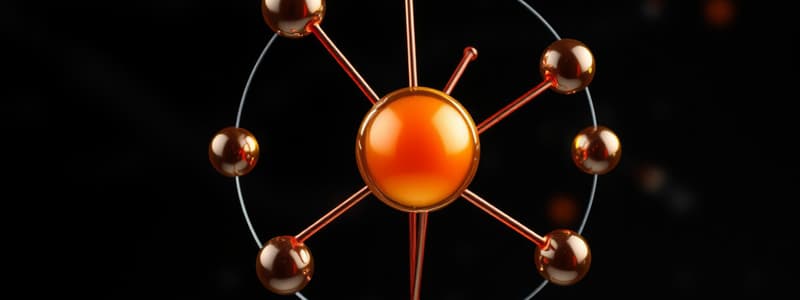Podcast
Questions and Answers
What characteristic defines chemically inert elements?
What characteristic defines chemically inert elements?
- They react readily with other elements.
- They have incomplete valence shells.
- Their outermost energy level is complete. (correct)
- They have a high electronegativity.
Which of the following elements is chemically inert?
Which of the following elements is chemically inert?
- Carbon (C)
- Helium (He) (correct)
- Oxygen (O)
- Hydrogen (H)
What is true about chemically reactive elements?
What is true about chemically reactive elements?
- They do not bond with other elements.
- They have more than 8 electrons in their valence shell.
- They tend to form ions. (correct)
- They have filled valence shells.
How many electrons are in the outermost shell of Neon (Ne)?
How many electrons are in the outermost shell of Neon (Ne)?
Which element has an incomplete outermost energy level?
Which element has an incomplete outermost energy level?
What is the maximum number of electrons that can occupy the second energy level?
What is the maximum number of electrons that can occupy the second energy level?
Which of the following statements about valence shells is correct?
Which of the following statements about valence shells is correct?
Which elements are most likely to form covalent bonds?
Which elements are most likely to form covalent bonds?
What characterizes an ionic bond?
What characterizes an ionic bond?
What is the charge of an anion?
What is the charge of an anion?
How do cations form?
How do cations form?
In covalent bonding, how are electrons shared?
In covalent bonding, how are electrons shared?
Which of the following molecules involves double covalent bonds?
Which of the following molecules involves double covalent bonds?
What type of bond forms when sodium and chlorine combine?
What type of bond forms when sodium and chlorine combine?
What is formed when electrons are shared in pairs?
What is formed when electrons are shared in pairs?
What type of bond is primarily responsible for the stability of compounds formed by nonmetals?
What type of bond is primarily responsible for the stability of compounds formed by nonmetals?
What are the particles found in the nucleus of an atom?
What are the particles found in the nucleus of an atom?
Which statement about ions is true?
Which statement about ions is true?
What defines a molecule?
What defines a molecule?
What is true regarding the valence shell of an atom?
What is true regarding the valence shell of an atom?
How many electrons can fit in the first shell of an atom?
How many electrons can fit in the first shell of an atom?
What is the primary reason helium is considered nonreactive?
What is the primary reason helium is considered nonreactive?
What type of bond is formed when atoms share electrons?
What type of bond is formed when atoms share electrons?
Which of the following compounds consists of different types of atoms combined?
Which of the following compounds consists of different types of atoms combined?
What characterizes nonpolar covalent bonds?
What characterizes nonpolar covalent bonds?
Why do polar molecules have a positive and negative side?
Why do polar molecules have a positive and negative side?
What is a common example of a polar molecule?
What is a common example of a polar molecule?
What are hydrogen bonds primarily formed between?
What are hydrogen bonds primarily formed between?
How do hydrogen bonds contribute to the properties of water?
How do hydrogen bonds contribute to the properties of water?
What type of bond would likely form between two carbon atoms in an alkane?
What type of bond would likely form between two carbon atoms in an alkane?
Why are hydrogen bonds considered weak relative to covalent bonds?
Why are hydrogen bonds considered weak relative to covalent bonds?
Which of the following is NOT a characteristic of polar molecules?
Which of the following is NOT a characteristic of polar molecules?
What type of reaction involves atoms or molecules combining and absorbing energy for bond formation?
What type of reaction involves atoms or molecules combining and absorbing energy for bond formation?
Which reaction type is primarily associated with breaking down molecules and releasing chemical energy?
Which reaction type is primarily associated with breaking down molecules and releasing chemical energy?
In what type of reaction are both synthesis and decomposition processes involved, where bonds are made and broken?
In what type of reaction are both synthesis and decomposition processes involved, where bonds are made and broken?
Which statement correctly describes the properties of water?
Which statement correctly describes the properties of water?
What type of compounds primarily have carbon in their structure and tend to be larger than inorganic compounds?
What type of compounds primarily have carbon in their structure and tend to be larger than inorganic compounds?
What is a key property of water that allows it to flow in narrow spaces against external forces like gravity?
What is a key property of water that allows it to flow in narrow spaces against external forces like gravity?
Which of the following correctly describes a characteristic of inorganic compounds?
Which of the following correctly describes a characteristic of inorganic compounds?
What kind of chemical reaction is most commonly reversible?
What kind of chemical reaction is most commonly reversible?
Flashcards are hidden until you start studying
Study Notes
Atomic Stability
- Atoms achieve stability by forming bonds that create a complete valence shell.
- Chemically inert elements, like Helium (He) and Neon (Ne), have complete outer energy levels with 2 and 8 electrons respectively.
- Chemically reactive elements, such as Hydrogen (H) and Carbon (C), have incomplete outer energy levels, prompting them to engage in chemical reactions.
Types of Chemical Bonds
Ionic Bonds
- Formed when electrons are fully transferred from one atom to another, allowing stability through electron transfer.
- Ions are formed from the loss or gain of electrons;
- Anions carry a negative charge from gaining electrons.
- Cations carry a positive charge from losing electrons.
- Opposite charges of cations and anions lead to attraction, holding them together in ionic bonds.
Covalent Bonds
- Atoms achieve stability by sharing electrons, commonly in pairs.
- Single covalent bonds involve the sharing of one pair of electrons while double covalent bonds involve two pairs.
- Examples include bonds between Carbon and Hydrogen (CH4) and various other combinations (C-C, O-O, etc.).
Molecular Structure
- Molecules consist of two or more atoms bonded together, either from the same or different elements.
- Compounds specifically form from different elements, such as methane (CH4), which includes Carbon and Hydrogen atoms.
Properties of Covalent Bonds
- Covalent bonds can be classified as nonpolar or polar:
- Nonpolar bonds share electrons equally, resulting in electrically neutral compounds like Carbon Dioxide (CO2).
- Polar bonds result in unequal sharing of electrons, creating a molecule with positive and negative poles, exemplified by water (H2O).
Hydrogen Bonds
- Form between molecules with polar covalent bonds, driving weak chemical interactions.
- Essential for properties like water’s surface tension and intramolecular bonding in proteins.
Subatomic Particles
- Atoms consist of protons (p+), neutrons (n0), and electrons (e–).
- Protons are positively charged, while electrons are negatively charged; neutrons have no charge.
- An electrically neutral atom has an equal number of protons and electrons, while ions have lost or gained electrons.
Chemical Reactions
Types of Reactions
- Synthesis Reaction: Combination of atoms/molecules (A + B → AB), energy is absorbed.
- Decomposition Reaction: Breakdown of molecules (AB → A + B), releasing energy.
- Exchange Reaction: Involves synthesis and decomposition (AB + C → AC + B).
Factors Influencing Reaction Rates
- Variability in speed of reactions can be influenced by temperature, concentration, and surface area.
Chemical Composition of Living Matter
- Inorganic compounds generally lack carbon, while organic compounds contain carbon and are molecularly larger, including carbohydrates, lipids, proteins, and nucleic acids.
Properties of Water
- Water's unique properties are due to hydrogen bonding:
- High heat capacity enables temperature regulation.
- Acts as a universal solvent due to its polarity.
- Exhibits capillary action and high surface tension due to cohesive interactions.
Summary
- Understanding atomic structure, chemical bonds, and the properties of molecules, especially water, is crucial for grasping biochemical processes and reactions that sustain life.
Studying That Suits You
Use AI to generate personalized quizzes and flashcards to suit your learning preferences.



